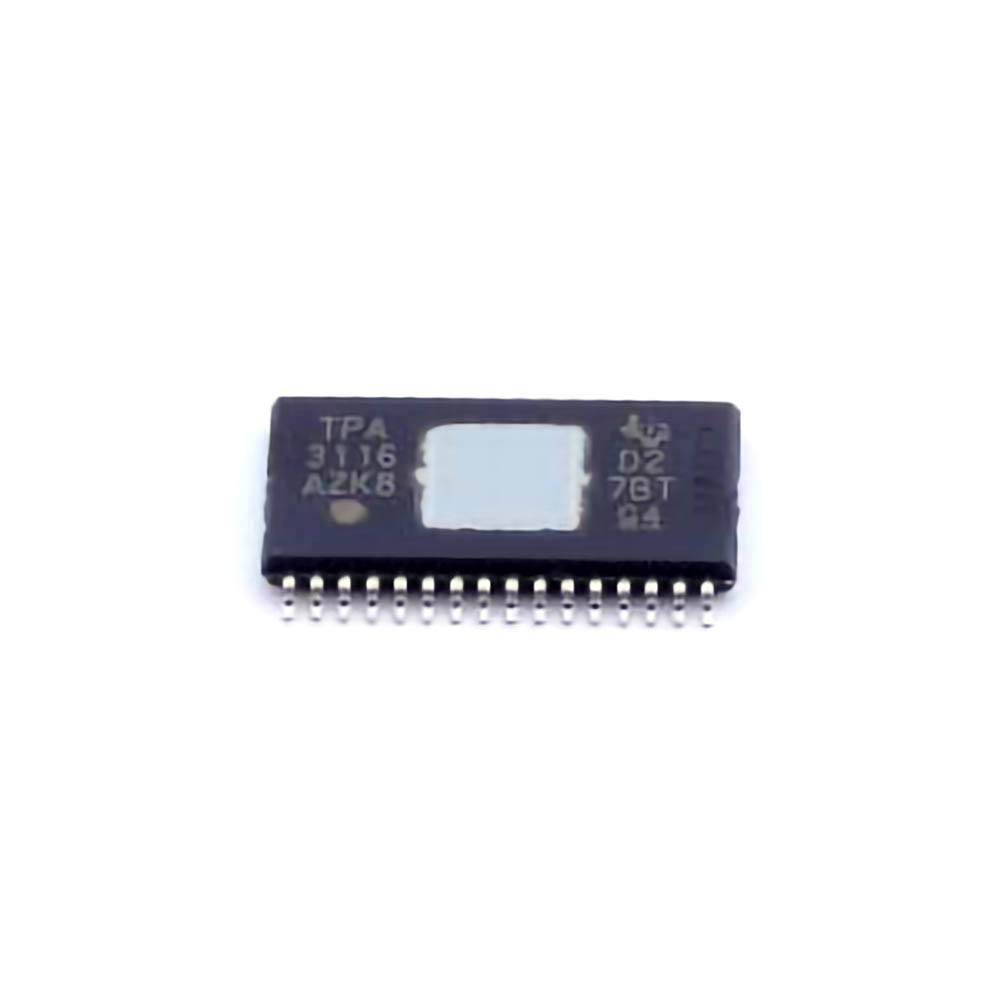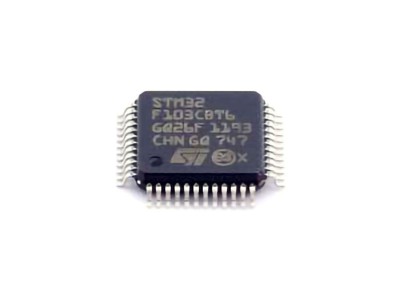
Common Issues with the TPA3116D2DADR and How to Diagnose Them
The TPA3116D2DADR is a high-efficiency class-D Audio amplifier often favored for its small footprint, low Power consumption, and impressive sound quality. However, like all electronic components, it is susceptible to certain issues, especially when used in DIY audio projects or integrated into consumer electronics.
1. No Sound Output
One of the most common issues when dealing with the TPA3116D2DADR is a complete lack of sound output. This could be due to various reasons, and here's how you can troubleshoot the problem:
Power Supply Issues: Ensure the power supply is working correctly. The TPA3116D2DADR typically operates within a voltage range of 4.5V to 26V, depending on the variant. If the voltage is too low or too high, the chip may not function properly. Use a multimeter to check the output of the power supply and verify that it meets the required specifications.
Speaker Connection: Double-check that your speaker wires are properly connected to the amplifier. Loose or disconnected wires can prevent sound from reaching the speakers.
Faulty Components: Another possibility could be a blown capacitor or a defective component on the PCB. Inspect the board for any visible damage, such as burnt areas, broken solder joints, or damaged capacitors.
Input Signal Issues: Ensure that an audio signal is being sent to the amplifier. Use an oscilloscope or a signal tracer to verify that the audio signal is reaching the input pins of the TPA3116D2DADR.
Protection Mode Activation: Some amplifiers, including the TPA3116D2DADR, have built-in protection circuits that shut down the output if a fault is detected. If the amplifier is in protection mode, check for short circuits, over-heating, or overloads.
2. Distorted Sound or Unclear Audio Quality
Distorted or fuzzy sound output is another common issue. If you're experiencing this problem, consider the following steps:
Overdrive or Overloading: The TPA3116D2DADR is a powerful chip, but it can still be overdriven, especially when paired with high-sensitivity speakers or excessive input signal levels. Lower the input signal or the gain settings on your amplifier to see if this resolves the distortion.
Power Supply Noise: Class-D amplifiers, including the TPA3116D2DADR, can be sensitive to power supply noise. A noisy or inadequate power supply could introduce interference that causes distortion. Use a well-filtered, regulated power supply with low ripple to ensure clean audio output.
Ground Loops and Interference: Ground loops can often introduce hum or distortion in audio systems. Ensure that your amplifier, audio source, and speakers are all properly grounded. Consider using a ground loop isolator to prevent this issue.
Poor Speaker Compatibility: Check if the impedance of the connected speakers is within the recommended range for the TPA3116D2DADR. Using speakers with a very low or very high impedance may lead to distorted audio or even damage to the amplifier.
3. Overheating or Thermal Shutdown
The TPA3116D2DADR features thermal protection, which automatically turns off the amplifier if it overheats. While this feature is beneficial for preventing damage, it can be inconvenient when the amplifier shuts down unexpectedly. If you're facing this issue, here are some potential causes:
Inadequate Cooling: If the amplifier is housed in a cramped enclosure or is not properly ventilated, it may overheat. Ensure that your setup provides adequate airflow to the amplifier. Using heat sinks or improving ventilation can significantly reduce the chances of thermal shutdown.
Excessive Load or Output Power: Running the amplifier at very high output levels or driving it with a heavy load can cause excessive heat generation. Ensure that you're not exceeding the recommended output power or speaker impedance.
Ambient Temperature: The TPA3116D2DADR's performance can also be affected by high ambient temperatures. Ensure that the amplifier is not exposed to direct sunlight or placed in an environment where it can heat up excessively.
Incorrect Wiring: Incorrectly wired output connections can cause the amplifier to overheat. Ensure that your wiring is properly configured according to the datasheet specifications, with all connections securely soldered and insulated.
4. Unstable or Fluctuating Output
Sometimes, users report that their TPA3116D2DADR produces unstable or fluctuating audio output. This can be caused by several factors:
Input Signal Fluctuations: If you're feeding the amplifier with an unstable or noisy input signal, the output will also be unstable. Make sure the audio source is working correctly, and consider adding filtering to reduce signal noise.
Poor PCB Design or Layout: A poorly designed PCB layout can lead to instability in the amplifier's operation. Ensure that the amplifier's circuit board is properly laid out with adequate trace width and grounding to minimize electromagnetic interference ( EMI ).
Component Failure: A failing capacitor, resistor, or transistor can result in an unstable output. Inspect the circuit board for any signs of damage or wear. If necessary, replace the faulty components to restore stability.
Advanced Troubleshooting for TPA3116D2DADR and Practical Solutions
In this second part, we will dive deeper into advanced troubleshooting methods and practical solutions for more complex issues with the TPA3116D2DADR.
5. Hum or Buzzing Noise in the Output
A persistent hum or buzzing sound, especially when no audio is playing, is a frustrating issue that many users experience with the TPA3116D2DADR. This is typically caused by electrical interference or ground loop problems.
Ground Loop Isolation: As mentioned earlier, ground loops are a common cause of humming or buzzing sounds. A ground loop isolator can be used between the amplifier and the audio source to break the loop and eliminate unwanted noise.
Shielding and Proper Grounding: If electromagnetic interference is the source of the hum, consider using shielded cables for your audio connections and ensure that the amplifier's enclosure is grounded. Using a metal enclosure can provide additional shielding from external noise sources.
Capacitor Addition: Adding a decoupling capacitor to the input or output of the amplifier can help filter out high-frequency noise and reduce hum or buzzing. Make sure the capacitors used are of good quality and suitable for the application.
6. Low Output Volume or Insufficient Power
Sometimes, the TPA3116D2DADR may produce low output volume, even when the input signal is strong and the amplifier seems to be working properly. Here’s how to address this issue:
Input Gain Settings: Many amplifiers, including the TPA3116D2DADR, have adjustable gain settings. Check to ensure that the gain is properly configured for your system and is not set too low.
Speaker Impedance and Sensitivity: If the speakers connected to the amplifier have low sensitivity or a high impedance, the output volume may be lower than expected. Consider using more efficient speakers or adjusting the system's gain to compensate for the reduced output.
Power Supply Insufficiency: Insufficient current from the power supply can limit the output power of the TPA3116D2DADR. Ensure that the power supply is capable of delivering enough current to the amplifier, especially at higher output levels. Check the specifications and choose a power supply that matches the requirements.
7. Intermittent or Complete Loss of Output
If the output suddenly drops or becomes intermittent, there could be several reasons behind this:
Loose or Faulty Connections: One of the most common causes for this type of issue is a loose wire or bad solder joint. Inspect all wiring and solder points to ensure they are secure and free of corrosion.
Overcurrent or Short Circuit Protection : The TPA3116D2DADR has built-in overcurrent protection, which can cause the amplifier to shut down if a short circuit is detected. Check for any shorted speaker wires or improperly connected components that could trigger this protection.
Software or Firmware Issues: In cases where the TPA3116D2DADR is part of a larger, more complex system, firmware or software issues could be the cause. Try resetting the system or updating the firmware to ensure everything is functioning as it should.
8. Advanced Testing Methods
For those who want to dive deeper into troubleshooting, using advanced testing tools like an oscilloscope can help identify issues that are not immediately visible. You can monitor the waveform of the input and output signals to detect clipping, distortion, or interference. Additionally, thermal cameras can help identify hot spots on the PCB that may indicate failing components.
Conclusion
The TPA3116D2DADR is a robust and reliable audio amplifier, but like all electronics, it can experience occasional issues. Whether you’re dealing with a lack of sound, distortion, overheating, or other problems, most of these issues can be diagnosed and resolved with a methodical approach. By following the troubleshooting steps outlined in this article, you can ensure that your TPA3116D2DADR provides optimal performance for years to come.
Partnering with an electronic components supplier sets your team up for success, ensuring the design, production, and procurement processes are quality and error-free.


